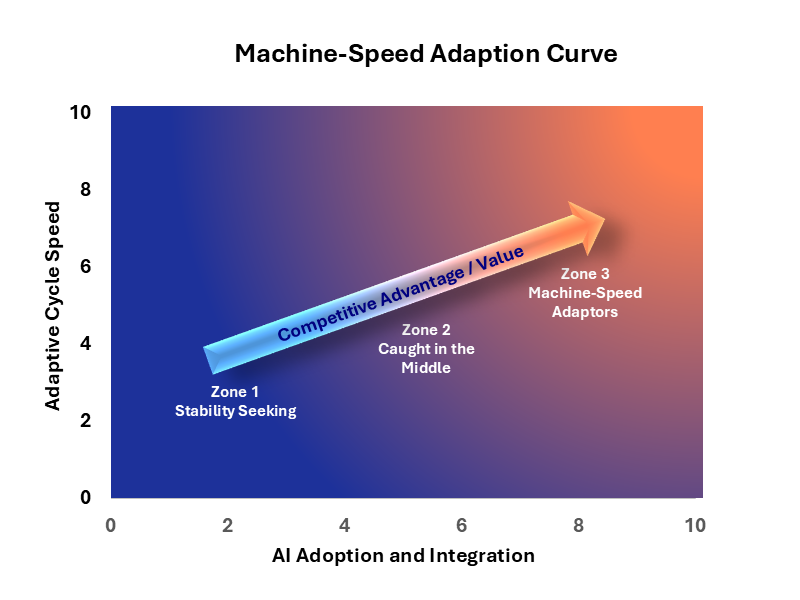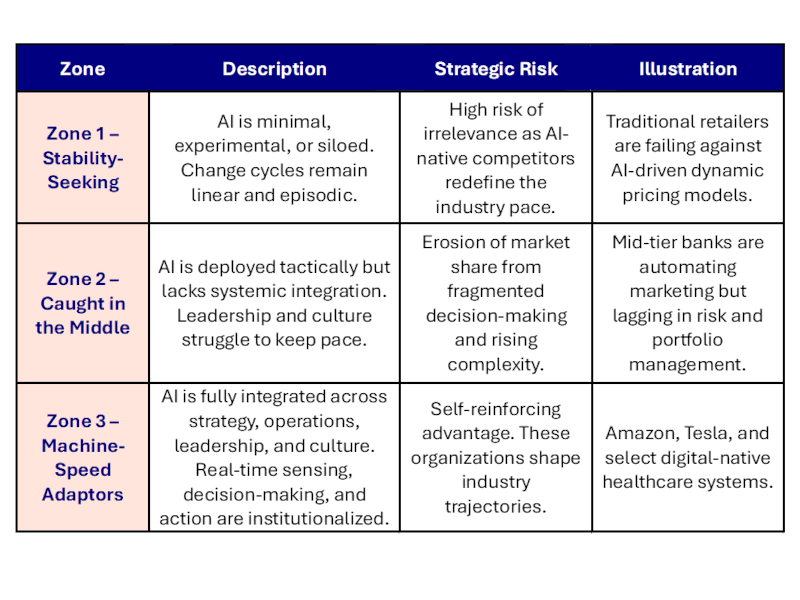In Brief
- AI is redefining the speed and nature of change, compressing decision cycles and rendering traditional planning, governance, and leadership models increasingly obsolete.
- Sustainable competitive advantage now depends on building machine-speed adaptability into the core of strategy, operations, leadership, and culture.
- Organizations must move beyond episodic transformation to perpetual reinvention, where resilience, human-AI collaboration, and ethical oversight determine who leads and who fades.
Executive Summary
Artificial Intelligence (AI) is not merely a passing trend; it is a powerful force that is rapidly reshaping the business landscape. It has compressed the time between sensing, deciding, and acting while disrupting traditional leadership, strategy, and operating models. The nature of change has shifted from episodic to continuous. AI is no longer just a tool to enhance human capability; it can now operate autonomously, necessitating adaptation at machine speed. The urgency to adapt to these changes is immediate and cannot be overstated.
This presents both a structural challenge and a significant opportunity. Organizations built for stability risk obsolescence, while those that infuse adaptability as a core capability can secure a strategic advantage, consistently sensing their environment, recalibrating their strategy, and acting in real time. This strategic advantage should not only inspire but also necessitate leaders to reimagine organizational execution and foster adaptability within their organizations continually.
The challenge is not just technological; it is existential. Leadership models rooted in linear planning cycles and human-centered decision-making are increasingly inadequate. Those who succeed will not only survive but also shape industries; those who fail will struggle to remain relevant in a world where perpetual reinvention is the new norm.
The Collapse of Stability — When Change Outruns Organizations
The 20th century rewarded organizations that managed disruption episodically. Strategic plans were updated annually. Execution cascaded through hierarchies—the core assumption being that change was intermittent, linear, and manageable.
AI has invalidated that model. Change is now constant, continuous, and self-reinforcing. Markets shift dynamically. Competitors pivot in days. Customer expectations evolve in real time. Strategic cycles that once spanned quarters or years now collapse into weeks, days, or moments. Whereas outcomes were once static and the means garnered the most attention, outcomes have become dynamic, with AI significantly affecting the means of those outcomes. This reversal in attention will necessitate a significant shift in how organizations think, communicate, hire, and allocate resources.
Tesla is an instructive example. Its vertically integrated model enables real-time data from vehicles to inform design, pricing, and production. Over-the-air software updates enhance vehicle functionality overnight. Tesla is not reacting to change—it is structurally designed for perpetual adaptation.
Most organizations are not. Legacy planning cycles, rigid operating models, and linear governance structures increasingly become liabilities rather than assets.
AI as a Force Multiplier and Autonomous Change Agent
AI fundamentally differs from earlier technological shifts. While electricity, computing, and the internet have expanded human capabilities, humans have maintained control, where problem-solving is linked to personal value and identity. In contrast, AI operates differently. It can adapt by learning, recalibrating, and initiating change without human intervention, which diminishes personal value and identity.
AI does not just process information; it drives outcomes. Generative models write, test, and optimize code. AI-driven pharmaceutical platforms simulate drug trials, identify compounds, and optimize candidates, compressing timelines from years to weeks.
Each AI iteration improves the system’s ability to sense, decide, and act. The feedback loop is exponential. Human-led cycles struggle to keep pace.
The Compression of Decision and Learning Cycles
Three industries illustrate the consequences:
- Finance – Algorithmic trading systems execute strategies in milliseconds, learning from every trade. Human traders are structurally outpaced (Brynjolfsson & McAfee, 2017).
- Pharmaceuticals – AI platforms refine molecules and model efficacy at speeds regulators can barely review, let alone match.
- Software Development – Generative AI reduces development cycles from months to hours. GitHub Copilot, for instance, generates and tests production-level code more quickly than teams can review it (McKinsey, 2023).
Strategic inflection points that once unfolded over the years now occur in moments. Delay means defeat. Generational speed was once gauged by mainframes, while another generation measured speed through distributed computing. In both eras, the pace of speed adapted to and became constrained by those limitations. AI is ushering in a new generation of speed, and part of the challenge in adoption lies in overcoming entrenched ways of thinking.
The Machine-Speed Adaptation Curve — Gryphon Citadel’s Strategic Lens
Gryphon Citadel uses the Machine-Speed Adaptation Curve to help leaders diagnose their organization’s position and define the path forward:


Competitive advantage and value increasingly accrue to Zone 3. The journey between zones is neither linear nor optional.
Organizational Redesign — Embedding Continuous Adaptability
Meeting the machine-speed challenge requires systemic organizational redesign. This is not a technology problem—it is a strategic, operational, and cultural shift.
Strategy as a Continuous, Living System
Annual strategic planning is obsolete. AI compresses decision windows, rendering static plans irrelevant. Organizations must build continuous sensing capabilities by integrating real-time data streams, scenario engines, and AI-augmented modeling.
Strategy becomes less about setting a direction and more about dynamic positioning—constantly adjusting based on evolving signals.
Operating Models for Distributed, Real-Time Action
AI-native operating models redistribute decision rights from headquarters to the edge. Frontline teams and AI agents can act on real-time insights. Hierarchical bottlenecks become liabilities. Modular, decentralized architectures enable rapid adjustment.
Decision-making shifts from control and compliance to speed, experimentation, and course correction in pursuit of dynamically changing outcomes.
Leadership Reimagined for Velocity and Complexity
Leadership models must evolve. Command-and-control no longer works at machine speed. Executives must become orchestrators—fluent in AI’s capabilities and limits, balancing speed with ethical judgment, thereby fostering a culture of responsibility and conscientiousness.
Core leadership competencies now include:
- AI fluency—understanding algorithmic reasoning and bias.
- Systems thinking—navigating complexity and interdependence.
- Emotional intelligence—building resilience and trust in high-velocity environments.
Human Capital and Cultural Transformation
Workforce models designed for static roles and repetitive tasks often fail to adapt in the face of AI-driven change.
The future workforce is dynamic, built around skills ecosystems, not job titles. AI-curated learning pathways replace episodic training. Human roles evolve toward curiosity, creativity, ethics, empathy, and systems integration, necessitating a culture of continuous learning and growth.
Cultures of experimentation, resilience, and continuous learning outperform those optimized for efficiency and risk aversion.
The Human Challenge — Cognitive Strain, Skill Obsolescence, and New Socioeconomic Divides
Humans evolved for periods of stability punctuated by change. Machine-speed environments reverse that, making change constant and stability fleeting.
Cognitive overload is inevitable without structural intervention. Decision fatigue, disengagement, and burnout shift from HR issues to strategic risks.
The World Economic Forum (2023) projects that 50% of today’s skills will change within five years. Professions once insulated—such as law, consulting, and design—face accelerating obsolescence as AI encroaches on cognitive and creative domains.
A new divide emerges:
- AI-Enhanced – Individuals and organizations capable of adapting at machine speed.
- AI-Obsolete – Those unable or unwilling to evolve.
However, this is also an opportunity. As AI absorbs cognitive load, human judgment, ethics, and creativity become increasingly valuable. Leaders must reframe and reward human work that focuses on what machines cannot do.
Ethical, Regulatory, and Societal Risks
Machine-speed decisions amplify ethical risks. AI optimizes for objectives, not values. Biases embedded in training data scale instantly. Black-box algorithms obscure accountability.
Healthcare, finance, and criminal justice offer stark warnings. AI-driven credit scoring, sentencing algorithms, and healthcare diagnostics risk perpetuating systemic bias or ethical failures at scale (OECD, 2023).
Regulatory frameworks, designed for human-paced review, struggle to govern AI systems operating at light speed.
Organizations must design for auditability, transparency, and ethical resilience. This is not about slowing AI—it is about preserving human values in systems that we increasingly do not fully comprehend.
Illustrative Scenarios — Winners, Losers, and the Path Forward
- Legacy Retail – Anchored in quarterly planning cycles and static supply chains. AI-native competitors deploy dynamic pricing, real-time inventory optimization, and hyper-personalized marketing, eroding market share.
- Tesla – Vertically integrated, software-defined product model enables real-time adaptation. AI-driven insights flow from vehicles to engineers, enabling rapid shifts in product, pricing, and strategy within days.
- Mayo Clinic – Leverages AI for predictive diagnostics and personalized care pathways. The result: improved outcomes, enhanced resource utilization, and a strengthened leadership position in healthcare innovation (Mayo Clinic, 2023).
Future scenarios are already unfolding:
- Autonomous supply chains self-optimizing around global disruptions.
- Smart cities manage infrastructure, energy, and public safety in real time.
- Markets where AI agents outnumber human traders and set prices at light speed.
The throughline is clear – machine-speed adaptors set the pace. Others chase—or vanish.
Strategic Imperatives — Architecting Machine-Speed Enterprises
Governance Reimagined
Boards and executive committees must shift from plan approval to dynamic oversight and management. Risk management evolves from monitoring static frameworks to navigating emergent and dynamic AI behaviors.
Ethical guardrails, algorithmic accountability, and dynamic risk sensing become board-level competencies.
Technology and Data Architecture
Enterprise architecture must support continuous sensing, reasoning, and acting. This requires:
- Integrated internal and external data streams.
- AI-driven optimization engines.
- Real-time feedback loops.
Cybersecurity, transparency, and resilience become as critical as processing speed.
Leadership and Workforce for Perpetual Reinvention
Leadership pipelines must evolve. Technical knowledge, systems thinking, and ethical reasoning are now as crucial as financial acumen.
Workforce models prioritize adaptability, continuous learning, and human-AI collaboration. Careers become portfolios of skills, not static job descriptions.
Resilience—individual and institutional—emerges as a strategic asset.
Actionable Recommendations for Executives
Conduct AI readiness and fatigue assessments. Map cognitive strain points, skill obsolescence risks, and governance vulnerabilities.
Re-architect strategy and operating models for continuous adaptation. Invest in leadership development focused on reimagination, AI fluency, and ethical judgment.
Institutionalize resilience, continuous learning, and ethical frameworks. Develop AI-human hybrid systems that strike a balance between human judgment and speed and efficiency.
From Keeping Up to Leading the Future
Machine-speed adaptation is not optional—it is the new baseline for relevance, resilience, and competitive advantage. AI has compressed decision cycles, redefined strategy, and exposed the inadequacy of linear change models.
The winners will not merely survive—they will lead. They will set the pace of change, not chase it. They will architect organizations designed for perpetual adaptation—combining the speed of AI with the judgment, creativity, and values of humanity.
Gryphon Citadel helps leaders make this leap, transforming how organizations think, operate, and thrive in the age of machine-speed change.
About Gryphon Citadel
Gryphon Citadel is a management consulting firm based in Philadelphia, PA. Known for our strategic insight, our team delivers invaluable advice to clients across various industries. Our mission is to empower businesses to adapt and flourish by infusing innovation into every aspect of their operations, leading to tangible, measurable results. Our comprehensive service portfolio includes strategic planning and execution, digital and organizational transformations, performance enhancement, supply chain and manufacturing optimization, workforce development, operational planning and control, and advanced information technology solutions.
At Gryphon Citadel, we understand that every client has unique needs. We tailor our approach and services to help them unlock their full potential and achieve their business objectives in the rapidly evolving market. We are committed to making a positive impact not only on our clients but also on our people and the broader community. At Gryphon Citadel, we transcend mere adaptation; we empower our clients to architect their future. Success isn’t about keeping pace; it’s about reshaping the game itself. The question isn’t whether you’ll be part of what’s next—it’s whether you’ll define it.
Our team collaborates closely with clients to develop and execute strategies that yield tangible results, helping them to thrive amid complex business challenges. Let’s set the new standard together. If you’re looking for a consulting partner to guide you through your business hurdles and drive success, Gryphon Citadel is here to support you.
Explore what we can achieve together at www.gryphoncitadel.com


